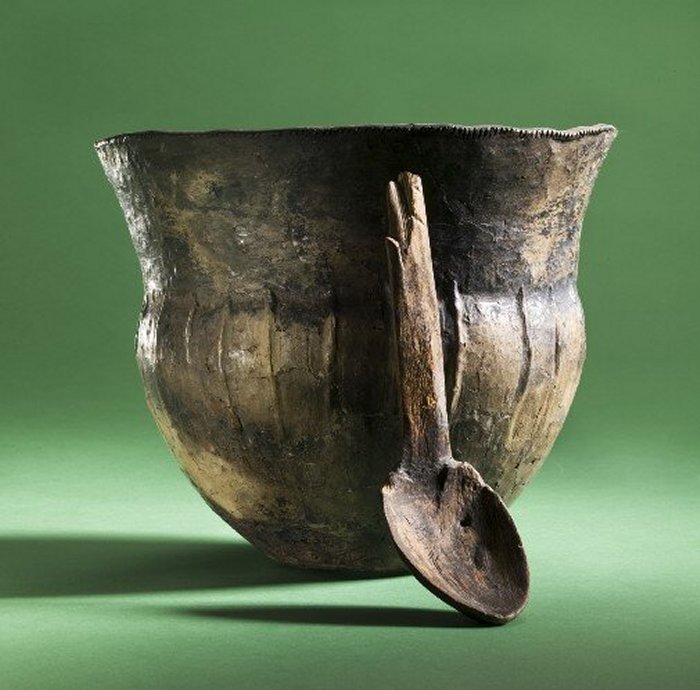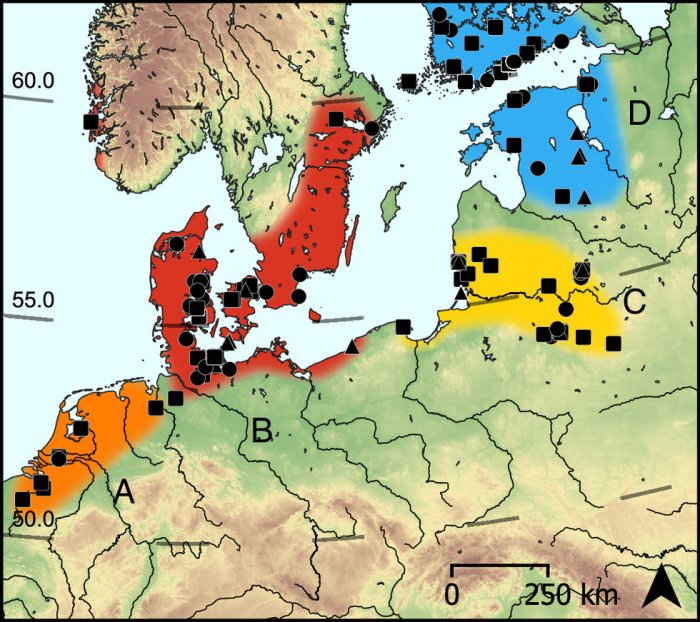Conny Waters – AncientPages.com – Pioneering early farmers who arrived on the Baltic coast 6,000 years ago may have taken up fishing after observing indigenous hunter-gatherer communities, a major new study has found.

Early Neolithic bog pot from Olvig Mose and wooden spoon from Tømmerup in Åmosen, Denmark. Credit: Arnold Mikkelsen, The National Museum of Denmark, CC BY-SA
Previous studies of prehistoric cooking pots in areas including Britain, Spain, France and Portugal have indicated that people completely stopped cooking fish once they started farming crops and animals, even in coastal areas.
In stark contrast, the new research, published in the Proceedings of the National Academy of Sciences and led by academics at the University of York in collaboration with the British Museum, has found that farmers who arrived on Northern Europe’s Baltic coast adopted a mixed diet that embraced both fish and domesticated animal products.
The researchers say their study, which looked at fats preserved in fragments from more than a thousand prehistoric vessels uncovered in the coastal area stretching from western Denmark to southern Finland, suggests there may have been close cooperation and interaction between new arrivals and local forager communities.
Significant contrast
Professor Oliver Craig, director of the BioArCh Lab at the University of York, where the study was conducted, said, “Our findings suggest that early farmers moved to this region rich in aquatic resources and adapted their economy and daily habits, such as diet and cooking practices, by observing indigenous hunter-gatherer-fishers they encountered. While this might seem like an obvious and logical strategy, it is in significant contrast to virtually all other Early Neolithic sites that are located in coastal areas, where we see no evidence that they made use of marine resources.
“We may never know for sure why these early agriculturalists embraced a fish diet while farmers in other regions comprehensively rejected aquatic resources. So far, genetic studies suggest there was very litt
Map of the study area showing the diachronic set of sites, dated between the 5th and 3rd millennia cal BCE, and the regional divisions (A–D) used in this study. Sampled archaeological sites with typical hunter-gatherer-fisher pottery (circle), early farmer pottery (square), or both (triangle) are shown. Individual sites are listed in SI Appendix, Fig. S1 and Dataset S1.
Professor Craig added, “The presence of dairy in hunter-gatherer pots from before the arrival of farming seems remarkable, but may be explained by the exchange of foods and perishable products with farming communities, located perhaps less than 100 km away.
“Our study paints a picture of the two culturally and socially distinct groups living side by side without admixing, but exchanging goods. Perhaps fermented dairy products such as ʙuттer were swapped for furs, oils derived from marine mammals, or honey.”
Ancient fats
The researchers extracted and analyzed fatty acids from the ancient pottery fragments dating from between 4,000 and 8,000 years ago using a process called gas chromatography-mᴀss spectrometry. This sophisticated technique revealed the kinds of organic substances the ancient fats and lipids originated from, with the results showing that around 50% of pots belonging to early farmers contained fish-based residues. Of the pots belonging to hunter-gatherer-fishers, 5% contained traces of dairy.
Lead author of the study, Dr. Alexandre Lucquin from the Department of Archaeology at the University of York, said, “In one of the biggest studies of its kind, we have used exciting new methods in archaeological science to extract and interpret the remains of meals prepared during a fascinating period of transition in human history. Our results show a surprising overlap in culinary practices between communities representing old and new ways of life and suggest that the transition to farming may have been a more gradual process rather than a sudden switch.”
Co-author of the study, Dr. Harry Robson from the Department of Archaeology at the University of York said, “The transition from foraging to farming is often viewed as homogenous throughout Europe. It is, however, becoming increasingly clearer that it was extremely complex and nuanced.
“In this study, we have shown that the early farmers of the western Baltic region used their pottery in a similar manner to the preceding hunter-gatherer-fishers in the region. It is intriguing that, aside from the Danube Gorges, this is the only region in Europe where this practice takes place. Equally, while it has long been recognized that the hunter-gatherer-fishers of the Ertebølle culture interacted with farmers across a frontier zone, we have the first widespread evidence that commodities, including dairy products, were exchanged.”
Mysterious
While the study offers new insights into the lives of our ancestors, many questions remain about this mysterious period.
Dr. Lucquin added, “There are many unanswered questions surrounding why people in Europe made such a large-scale and definitive shift to farming at this time. Perhaps they believed this new lifestyle offered more predictable resources.
“Once the Neolithic revolution began there was no going back for humanity and we may never really know what happened to the last hunter-gatherers of Europe.”
Paper
Written by Conny Waters – AncientPages.com Staff Writer





